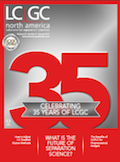Haven't We Been Doing Multidimensional GC Analysis Forever? So, What Is New?
Special Issues
Philip J. Marriott

Multidimensional analysis (MDA) certainly has been done for a long time! Many people are, to a lesser or greater degree, experienced in MDA. By MDA, we mean hyphenated chemical analysis combining two distinct techniques that themselves are bona fide analysis methods. The most recognizable MDA technique is gas chromatography–mass spectrometry (GC–MS)-combining dimensions of GC, which generates a sequence of time-resolved components and potentially constitutes molecular speciation, with a mass spectrum that provides some measure of molecular specificity by virtue of the mass fragmentation pattern of a molecule. By all accounts, GC–MS operates reliably, reproducibly, and sensitively for components detected by MS, for a sample that is resolved into chemical components by GC. Without further information, GC lacks molecular specificity, since it just gives the recognized peak response to each compound in a sample. If we can assign each response to a specific compound, then GC provides reliable molecular information. Thus, GC–MS is used as both a screening and target analysis method-we get a snapshot of the total sample or we can analyze a subset of compounds.
This approach is acceptable, but there are significant provisos. Single resolved components allow MS-to the best of its ability-to give an indication of identity and amount of the compound. But two basic problems exist: MS may be incapable of correctly identifying compounds, and for samples with many components and considerable overlaps the mass spectrum is a composite result of all these overlaps. The first problem is a basic limitation of the mass spectrum; many compounds have similar MS data (for example, isomers) so they lack specificity. In this case, a compound’s GC retention index might be used as a further filter for identification. For the latter, deconvolution or MS/MS operation might reveal the presence of a given compound, where for MS/MS a specific ratio of precursor and product ion might be sufficient to confirm a compound.
Another option exists for MDA and it involves multidimensionality of separation. Described soon after the introduction of GC, and best implemented by microfluidic Deans switching, today multidimensional GC (MDGC) is well-established, with a number of manufacturers offering their own version of devices, supported by software method development (1). There is essentially only one driver for which MDGC is required, which is to resolve regions that are unresolved on a first column (first dimension [1D]) by transfer (heart-cut) to a second column (second dimension [2D]), which logically will be a different separation mechanism-for GC this need for a different separation mechanism is translated into columns of different polarity. An obvious key application is the analysis of chiral compounds, where unresolved enantiomers on an achiral column are transferred to a suitable enantioselective 2D column. In this case, methods are usually based on classical-length 1D and 2D columns, so elution on the latter column is not fast and normally only a few selected regions are cut to the 2D column (2).
This approach has an obvious limitation. For a sample with essentially overlapping components over its full elution range, it would be desirable to apply the advantage of the two-column separation to the total sample. In this case, no decision needs to be made regarding transfer of a few limited regions; sampling should be conducted continuously. Giddings proposed a solution: to sample across the 1D separation, but ensure that the sampling process does not reduce the resolution that had already been achieved on the 1D column. The logical outcome is that the 2D elution should be faster than the elution duration (width) of a 1D peak; the 2D column should be short enough to complete the analysis in the same time as 1D is sampled. This approach was put into practice by Phillips, who is credited with the development of comprehensive 2D-GC (GC×GC) (3). Although most of the proponents of GC×GC study samples with high complexity, and demonstrate exceptionally high resolution across the total elution range (4–7), the uptake of GC×GC is far less than one might predict based on the general need to analyze these sorts of samples. One unique and perhaps less exploited property of GC×GC is that the resulting 2D space, comprising the 1D and 2D elution times, is a very precise chemical property “map.” Thus a compound will be located in a specific position in the 2D plot as a result of its physicochemical properties-boiling point, and specific interaction mechanisms with each stationary phase, under the prevailing temperature conditions. Therefore, it is often stated that GC×GC provides “structure” in the 2D space, such that compounds are located in zones that reflect their related properties. On a low-polarity 2D column, alkanes will be eluted latest; with a high-polarity 2D phase alkanes will be eluted earliest on the 2D column. Recently, it has been proposed that pressure tuning of a 1D column ensemble (dual columns)-a process that effectively alters the apparent polarity of the 1D separation-allows peaks in a sample to alter their relative position, and might be useful in tuning the 2D orthogonality of the experiment and simplify method development (8).
Multidimensionality has been further extended to related designs for multiple separation dimensions, with multiple columns interfaced in a facile manner, various flow switching devices and cryotrapping procedures, permitting an array of new operational procedures in advanced MDA. These include a comprehensive three-dimensional (3D) experiment (GC×GC×GC) (9,10), and a hybrid GC×GC–GC method, which combines GC×GC with heart-cutting and then elution on a third column (11). This approach was recently applied in a four-column GC×GC–GC–GC experiment, to study the separation of E/Z and R/S isomers of oximes; each isomer was subjected to chemical transformation on a third column, and then their isomeric abundance was measured on a fourth column (12). Such novel hybrid GC designs and applications cannot be conducted in a conventional GC arrangement. These multidimensional advances have moved beyond conceptualization to implementation and optimization, to benefit chromatographers in ways not possible in 1D and 2D GC methods. Unquestionably, very complex samples can be better resolved (ideally with solutes completely resolved) using these advanced MDA techniques, with more information extracted to meet analysts’ objectives.
References
- K.M. Sharif, S.-T. Chin, C. Kulsing, and P.J. Marriott, TrAC Trends Anal. Chem.82, 35–54 (2016).
- Y.F. Wong, R.N. West, S.-T. Chin, and P.J. Marriott, J. Chromatogr. A1406, 307−315 (2015).
- Z. Liu and J.B. Phillips, J. Chromatogr. Sci.29, 227–231 (1991).
- B. Mitrevski, K. Kouremenos, and P.J. Marriott, Bioanalysis1, 367–391 (2009).
- P.J. Marriott, S.-T. Chin, B. Maikhunthod, H.-G. Schmarr, and S. Bieri, TrAC Trends Anal. Chem.34, 1–21 (2012).
- S.-T. Chin and P.J. Marriott, Chem. Commun. 50, 8819–8833 (2014).
- Y. Nolvachai, C. Kulsing, and P.J. Marriott, Crit. Rev. Environ. Sci. Technol.45, 2135–2173 (2015).
- K.M. Sharif, C. Kulsing, and P.J. Marriott, Anal. Chem.88, 9087–9094 (2016).
- N.E. Watson, H.D. Bahaghighat, K. Cui, and R.E. Synovec, Anal. Chem.89, 1793−1800 (2017).
- N.E. Watson, S.E. Prebihalo, and R.E. Synovec, Anal. Chim. Acta, in press, DOI: https://doi.org/10.1016/j.aca.2017.06.017 (2017).
- B. Mitrevski and P.J. Marriott, Anal. Chem. 84, 4837−4843 (2012).
- Y.F. Wong, C. Kulsing, and P.J. Marriott, Anal. Chem.89, 5620−5628 (2017).
Philip J. Marriott and Yong Foo Wong are with the Australian Centre for Research on Separation Science in the School of Chemistry at Monash University in Victoria, Australia.

Analysis of Pesticides in Foods Using GC–MS/MS: An Interview with José Fernando Huertas-Pérez
December 16th 2024In this LCGC International interview with José Fernando Huertas-Pérez who is a specialist in chemical contaminants analytics and mitigation at the Nestlé Institute for Food Safety and Analytical Sciences at Nestlé Research in Switzerland, In this interview we discuss his recent research work published in Food Chemistry on the subject of a method for quantifying multi-residue pesticides in food matrices using gas chromatography–tandem mass spectrometry (GC–MS/MS) (1).
The Use of SPME and GC×GC in Food Analysis: An Interview with Giorgia Purcaro
December 16th 2024LCGC International sat down with Giorgia Purcaro of the University of Liege to discuss the impact that solid-phase microextraction (SPME) and comprehensive multidimensional gas chromatography (GC×GC) is having on food analysis.

















